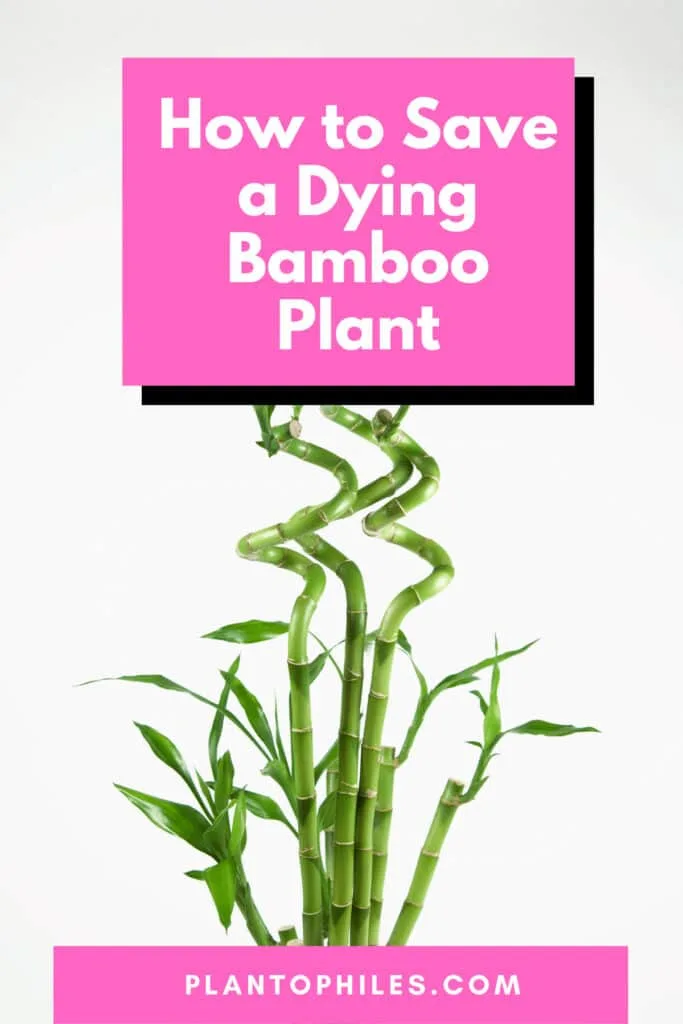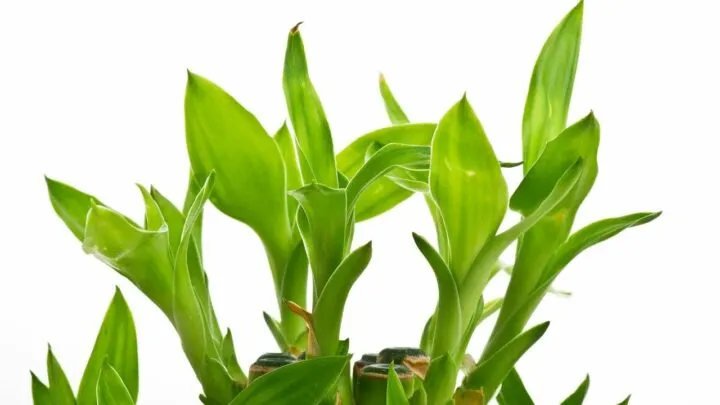You have a lucky bamboo plant at home. Maybe you have it in your bathroom or living room in a vase. It looks like it is dying. So now you are looking into how to save a dying bamboo plant.
What is a Lucky Bamboo Plant?
Did you know that the indoor lucky bamboo plant is a member of the lily family and technically not genuine bamboo?
While it may not be “real” bamboo, lucky bamboo is one of the most popular houseplants and one of the easiest to care for.
If your lucky bamboo is yellow or looks like it’s dying, don’t panic. This feng shui staple is hardy and should revive quickly as long as it’s not too far gone.
It’s quite simple to save your lucky bamboo and help bring it back to life from near-death conditions.
With these tips and steps, you can easily turn your dying bamboo plant into a beautiful, green, and healthy shoot again.
Table of Contents
How to Save a Dying Bamboo Plant
The first step to save a dying bamboo is to prune any yellowing or dead shoots. Add a mixture of aloe vera gel, liquid fertilizer, and water into its container. Place the newly pruned bamboo shoot in the container, add more water until the roots are submerged, and put it in a shady area.

How to Revive a Yellow, Dying Bamboo
To save a dying bamboo plant, the first step is to determine why it’s dying in the first place. It could be due to chemicals in the water, too much direct sunlight, or unacceptable growing conditions. It could even be dying because of an insect infestation.
Wash the leaves and shoots to remove dust, dirt, or insects.
Then, trim off the yellow and dead shoots with a pair of pruning shears to encourage new growth.
Next, you’re going to create a simple mixture. Take some aloe vera gel, and a small amount of liquid fertilizer (properly diluted), and mix it in your chosen potting container or vase.
Add water to the newly-created mixture, and then gently place the shoot in the pot. Add more water to cover the roots completely.
It’s important to remember that the new shoot needs to stay in a shaded area where it won’t always be in direct sunlight.
Lucky bamboo doesn’t like direct sunlight, which can cause it to wilt, curl, and yellow.
Don’t shade it too much because that can cause discoloration or wilting.
Why Lucky Bamboo Leaves Are Yellowing
If the leaves look yellow on your lucky bamboo, it’s essential to find out the underlying cause so you can fix it using the proper method.
Generally, bamboo can turn yellow for different reasons: temperature, fertilizer, water, or light.
Improper management of these four factors can cause an otherwise healthy lucky bamboo to turn yellow and inevitably start to die.
Another common cause of lucky bamboo plants turning yellow and dying is mealybugs, which can devastate a lucky bamboo.
That’s why keeping a close eye on your plant to ensure it’s healthy and thriving instead of feeding a small army of insects is crucial.
The symptoms of a mealybug infestation are unmistakable. Look for premature leaf drop and for honeydew, which is a sticky and shiny substance.
The mealybugs excrete the honeydew after feeding on the bamboo plant. The honeydew creates the perfect conditions for a black, ashy-looking mold, which will cause noticeable black spots on the leaves.
The mealybugs are pinkish-gray and typically have a white wax on their bodies.
To get rid of an active infestation, try spraying them off with water, pruning infested shoots, or even using chemical means, like horticultural oil or insecticidal soap.
Stay away from broad-spectrum pesticides that could also harm beneficial insects.
The Type of Water A Lucky Bamboo Likes
Most indoor houseplants can exist on ordinary tap water.
However, a lucky bamboo plant is slightly more sensitive than an indoor houseplant. They don’t like tap water because it’s treated with chlorine and fluoride.
Exposing your lucky bamboo to chlorinated tap water can be damaging. The leaves wilt and turn yellow, and eventually, the plant will die.
To give your bamboo clean water from the tap, leave a cup or bowl out all night so the chlorine will dissipate, and then water it in the morning.
Another option is investing in a water filter, which is much faster and more convenient than leaving a bowl of water out all night.
The Right Frequency For Changing Soil and Water
A very popular option is to pot lucky bamboo in water with a substrate, like small pebbles or decorative rocks.
If you’re using this potting method, it’s essential to keep the roots submerged in the water at all times.
Bamboo can also thrive in soil, so it’s your choice what medium to plant it in.
If you use water, empty and refill the old water with clean, fresh, filtered water at least every two weeks.
This helps provide the bamboo with life-giving nitrogen, oxygen, and other trace minerals the plant needs to thrive.
Dirty, stagnant water can cause mold, algae, or other contaminants that can harm your plant.
Identifying Root Rot In Your Bamboo Plant
Root rot is typically caused by a bamboo plant sitting in old or dirty water for too long, which creates harmful conditions conducive to this devastating root disease.
However, there’s an easy way to tell if your bamboo is suffering from root rot: take a close look at the color of its roots.
Healthy bamboo plants have orange roots. Rotting roots will be brown or black, so they’re easily identifiable.
If the yellowing on the stem starts at the bottom, it’s also a big red flag that the plant is suffering from root rot.
Bamboo Plant’s Ideal Growing Conditions
The ideal conditions for a bamboo plant to stay healthy is to keep it relatively warm, preferably between 68 and 85 degrees Fahrenheit.
Many houseplants don’t do well in cold temperatures; lucky bamboo is no exception.
Only use filtered, clean, and chemical-free water, and change it every two weeks.
Remember, avoid keeping the bamboo in direct sunlight, which can harm the plant.
Conclusion
When reviving a near-dead lucky bamboo, determining the cause of the yellowing leaves and shoots is the first step.
The best general method for saving this popular houseplant is to prune off the dead growth and then re-pot the shoots in aloe vera gel, liquid fertilizer, and water.
Then, be sure you’re giving your lucky bamboo ideal growing conditions, like a well-shaded area, warmer temperatures, and clean, filtered water.
Before you know it, your lucky bamboo will be beautiful, tall, and green again.

Daniel has been a plant enthusiast for over 20 years. He owns hundreds of houseplants and prepares for the chili growing seasons yearly with great anticipation. His favorite plants are plant species in the Araceae family, such as Monstera, Philodendron, and Anthurium. He also loves gardening and is growing hot peppers, tomatoes, and many more vegetables.


